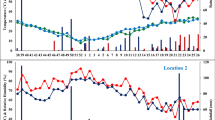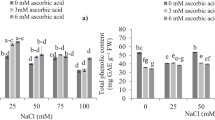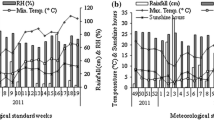Abstract
GA3 can be beneficial to improve the flowering yield in Lagenaria siceraria (Mol.) Standl. and Luffa cylindrica L. (Roem) treated with HgCl2 and \(\hbox{Pb}(\hbox{NO}_{3})_{2}\). This paper reviews the literature on the possible involvement of gibberellins in flower development and suggests that plants under the stress of heavy metals can be treated with GA3 to improve growth parameters, to avoid delay in flowering and likewise quality of fruit can be improved. Applied GA3 (400 mg/l) caused precocious flowering, increasing the number of flowers in the treated plants. All data was compared with control plants grown under similar conditions. Both heavy metals caused significant delay in flowering, consequently leading to reduction in the number of flowers. However, when GA3 was applied with HgCl2 and \(\hbox{Pb}(\hbox{NO}_{3})_{2}\), there was less decrease in staminate and pistillate flowers, revealing the dominant effect of GA3. Current work reveals that inhibitory effects of heavy metals on flowering can be partially restored with GA3 application.
Similar content being viewed by others
References
Aach H, Bode H, Robinson DG, Graebe JE (1997) ent-Kaurene synthase is located in proplastids of meristematic shoot tissues. Planta 202:211–219
Achard P, Herr A, Baulcombe DC, Harberd NP (2004) Modulation of floral development by a gibberellin-regulated microRNA. Develop 131:3357–3365
Ashraf F, Karim F, Rasul E (2002) Interactive effects of gibberellic acid (GA3) and salt stress on growth, ion accumulation and photosynthetic capacity of two spring wheat (Triticum aestivum L.) cultivars differing in salt tolerance. Plant Growth Regul 36:49–59
Biles SP, Cothren JT (2001) Flowering and yield response of cotton to application of mepiquat chloride and PGR-IV. Crop Sci 41:1834–1837
Bonetta D, McCourt P (2005) Plant biology: a receptor for gibberellin. Nature 437:627–628
Chaudhry NY, Khan AS (2000) Effects of growth hormones i.e., GA3, IAA and Kinetin on (1) Length and diameter of shoot (2) Early initiation of cambium and metaxylem elements in Cicer arietinum L. Pak J Bio Sci 3:1263–1266
Chen J, Henny RJ, McConnell DB, Caldwell RD (2003) Gibberellic acid affects growth and flowering of Philodendron. Plant Growth Regul 41:1–6
Cheng ST, Chen WS, Koshioka M, Mander LN, Huang KL, Du BS (2001) Gibberellins in relation to flowering in Polianthes tuberosa. Plant Physiol 112:429–432
Ganelevin R, Zieslin N (2002) Contribution of sepals and gibberellin treatments to growth and development of rose (Rosa hybrida) flowers. Plant Growth Regul 37:255–261
Gothberg A, Greger M, Holm K, Bengtson BE (2004) Influence level on uptake and effects of mercury, cadmium and lead in water spinach. J Environ Qual 33:1247–1255
Guo D, Shah G, Zeng G, Zheng S (2004) The interaction of plant growth regulators and vernalization on the growth and flowering of cauliflower (Brassica oleracea var. botrytis). Plant Growth Regul 43:163–171
Janowska B, Jerzy M (2003) Effect of gibberellic acid on post-harvest leaf longevity of Zantedeschia elliottiana (w. wats.). Engl J Fruit Orna Plant Res 11:69–76
Kadioglu A, Atalay F (2002) Effect of GA3 and IAA on major biochemical changes in Diospyros lotus fruits. Biologia Bratisl 57:125–130
Kevresan S, Petrovic N, Popovic M, Kandrac J (2001) Nitrogen and protein metabolism in young pea plants as affected by different concentrations of nickel, cadmium, lead, and molybdenum. J Plant Nutr 24:1633–1644
Kovacevic G, Kastori R, Merkulov L (1999) Dry matter and leaf structure in young wheat plants as affected by cadmium, lead and nickel. Plant Biol 42:119–123
Kulaeva ON, Prokoptseva OS (2004) Recent advances in the study of mechanisms of action of phytohormones. Biochemistry 69:233–247
Luo Y, Rimmer D (1995) Zinc–copper interaction affecting plant growth on a metal-contaminated soil. Environ Pollut 88:79–83
Mausth JD (2003) Botany: an introduction to plant biology. Jones and Bartlett Publishers, Canada, p 264
Naor V, Kigel J, Ziv M (2004) Hormonal control of inflorescence development in plantlets of calla lily (Zantedeschia spp.) grown in vitro. Plant Growth Regul 42:7–14
Neculita CM, Gerald JZ, Louis D (2005) Mercury speciation in highly contaminated soils from Chlor-Alkali plants using chemical extractions. J Environ 34:255–262
Olivares E, Pena E, Aguiar G (2002) Metals and oxalate in Tithonia diversifolia (Asteraceae): concentrations in plants growing in contrasting soils, and Al induction of oxalate exudation by roots. J Plant Physiol 159:743–749
Patra M, Sharma A (2000) Mercury toxicity in plants. Bot Rev 66:379–422
Patra M, Bhowmik N, Bandopadhyay K, Sharma A (2004) Comparison of mercury, lead and arsenic with respect to genotoxic effects on plant systems and the development of genetic tolerance. Environ Exp Bot 52:199–223
Parys E, Romanowska E, Siedlecka M, Poskuta JW (1998) The effect of lead on photosynthesis and respiration in detached leaves and in mesophyll protoplasts of Pisum sativum. Acta Plant Physiol 20:313–322
Salt DE, Blaylock M, Kumar PB, Dushenkov V, Ensley BD, Chet I, Raskin I (1995) Phytoremediation: a novel strategy for the removal of toxic metals from the environment using plants. Biotech 13:468–475
Saunder MJ (1991) Abstracts of the 14th international conference on plant growth regulators. Amsterdam, July 21–26, Agricultural University, Wageningen, p 37
Steel RGD, Torrie JH (1981) Principles and procedures of statistics. New York
Taiz L, Zeiger E (1991) Auxin growth and tropism. In: Plant physiology. The Benjamin/Cummings Publishing Co. Inc. California, p 342
Telfer A, Bollman KM, Poethig RS (1997) Phase change and the regulation of trichome distribution in Arabidopsis thaliana. Develop 124:645–654
Thangavel P, Sulthana AS, Subburam V (1999) Interactive effects of selenium and mercury on the restoration potential of leaves of medicinal plants Portulaca oleracea L. Sci Total Environ 243–244:1–8
Tomar M, Kaur I, Bhatnagar N, Bhatnagar AK (2000) Effect of enhanced lead in soil on growth and development of Vigna radiata (L). Wilczek. Indian J Plant Physiol 5:13–18
Tooke F, Ordidge M, Chiurugwi T, Battey N (2005) Mechanisms and function of flower and inflorescence reversion. J Exp Bot 56:2587–2599
Ulger S, Sonmez S, Karkacier M, Ertoy N (2004) Determination of endogenous hormones, sugars and mineral nutrition levels during the induction, initiation and differentiation stage and their effects on flower formation in olive. Plant Growth Regul 42:82–95
Vaituzis Z, Nelson JD, Wan LW, Colwell R (1975) Effects of mercuric chloride and morphology of selected strains of mercury resistant bacteria. Appl Microbiol 29:275–286
Van Assche F, Clijsters H (1990) Effects of heavy metals on enzyme activity in plants. Plant Cell Environ 13:195–206
Weiss D, Halevy AH (1989) Stamens and gibberellin in the regulation of corolla pigmentation and growth in Petunia hybrida. Planta 179:89–96
Wojciechowska-Mazurek M, Zawadzka T, Karlowski K, Cwiek-Ludwicka K, Brulinska-Ostrowska E (1995) Content of lead, cadmium, mercury, zinc and copper in fruit from various regions of Poland. Rocz Panstw Zakl Hig 46:223–238
Author information
Authors and Affiliations
Corresponding author
Rights and permissions
About this article
Cite this article
Chaudhry, N.Y., Khan, A.S. Improvement of pistillate flowers yield with GA3 in heavy metals treated plants. Plant Growth Regul 50, 211–217 (2006). https://doi.org/10.1007/s10725-006-9133-3
Published:
Issue Date:
DOI: https://doi.org/10.1007/s10725-006-9133-3




